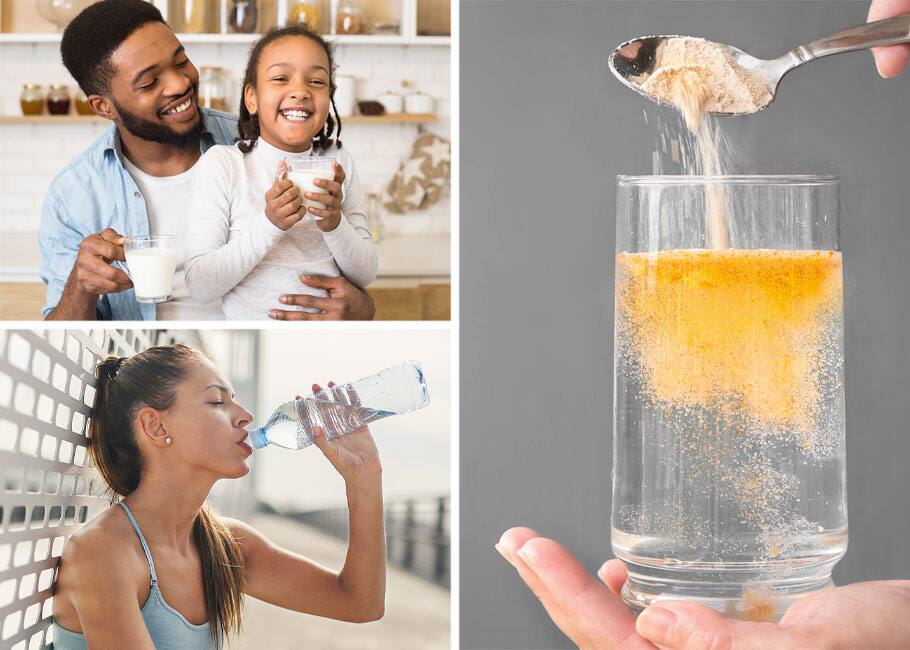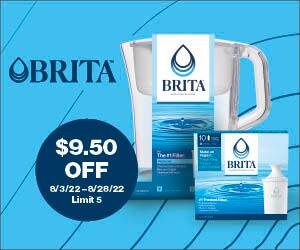Costco Connection | August | For Your Health | Liquid life

CLOCKWISE FROM TOP LEFT: © Prostock-studio ; globalmoments ; Jelena / STOCK.ADOBE.COM
Liquid life
Staying on top of the body’s hydration needs is vital to maintain and improve one’s health
Everyone needs water. Nearly all of the body’s major systems depend on it to function and survive.
According to the Centers for Disease Control and Prevention (CDC), maintaining proper hydration helps remove waste from the body; control body temperature, heart rate and blood pressure; support a healthy metabolism; protect the spinal cord and other sensitive tissues; and lubricate joints.
However, research shows that most of us are not hydrating enough.
The U.S. National Academies of Sciences, Engineering and Medicine determined that an adequate daily fluid intake is about 15.5 cups of fluids a day for men and about 11.5 cups of fluids a day for women. A CDC study conducted between 2015-2018 found that U.S. adults only drank an average of 5.5 cups of water and children and adolescents 2.9 cups on a given day.
“People tend to be underhydrated, meaning they aren’t getting adequate amounts of water to be in an optimal state of hydration and health,” says Stavros Kavouras, an assistant dean of graduate education and professor of nutrition at Arizona State University who directs the school’s Hydration Science Lab.
Dangers of dehydration
Symptoms of dehydration include confusion, muscle fatigue, tiredness, dizziness, headaches, cramping, anxiousness, increased thirst and decreased or darkened urine output, the CDC says.
“If you get too far behind on your fluids, your blood pressure can go too low,” says Dr. Mitchell Rosner, a nephrologist with a clinical focus on fluid and electrolyte disorders, acute kidney injury and polycystic kidney disease at the University of Virginia. “In more extreme cases, heatstroke can occur.”
Anyone can become dehydrated, but certain people are at a greater risk, including infants and children, the elderly, those with chronic illnesses and people who work or exercise outside, particularly in hot environments.
Drink up
Rosner says listening to your body is the safest way to know when to hydrate. “The body has an innate thirst mechanism. We want people to keep a sense of how much fluid they are losing and drink to thirst. That is a great guide to help you so you’re aware of your body. Exact amounts are variable to environmental conditions, current health and medications.”
Hydration options
When you’re thirsty, “water should be your first choice,” Rosner says. “Then people can have their own flavor choices that are palatable.”
Alternatives to plain water include hydration powders and bottled sports drinks, infused water, sparkling water, coconut water, cucumber juice, herbal teas, and aloe water or aloe vera juice.
Fluids with electrolytes and some carbohydrates can be an effective way to rehydrate and refuel the body, according to Mayo Clinic. Sean Lavin, vice president of mission at Liquid I.V., a Costco supplier, agrees. “Electrolyte drinks that contain glucose, sodium and potassium can help combat dehydration,” he says.
The bottom line
Staying hydrated is important. Make life easier on yourself by carrying a water bottle and keeping it filled. Added flavor can make it tastier and, in some instances, even more hydrating. And if you don’t like drinking a lot of water at once, eat foods that are high in water content (see “Surprising hydration options”) and try smaller doses of liquids spread throughout the day. Your body will thank you.
Your water timing?
Certain times are best for hydrating to maximize the water’s effectiveness on your body, according to Sarah Krieger, a Florida-based registered dietitian, nutritionist and chef. These include:
- Hydrating the day before you are out in the heat to prevent dehydration
- Consuming water before meals to satiate and avoid bloating and poor digestion
- Drinking a glass of water first thing in the morning to set the tone for the day
- Consuming more water in the first half of the day to avoid getting up at night—DJ
Surprising hydration options
Here is a list of other hydration sources:
Oatmeal. The oats expand and absorb water.
Low-fat or fat-free milk. According to a study by McMaster University, milk hydrates better than water or sports drinks due to its protein, carbohydrate, calcium and electrolyte content.
Fruits and smoothies. Eat or blend watermelon, grapes, grapefruit, strawberries, blueberries, peaches and other juicy fruits to increase hydration.
Vegetables and salads. Most lettuce greens contain at least 94% water. Celery, cucumbers, tomatoes, bell peppers, spinach and carrots are great hydrating additions.—DJ
Costco Connection: Find a variety of hydration options in Costco warehouses and at Costco.com, including Kirkland Signature™ products, Gatorade and Liquid I.V.



